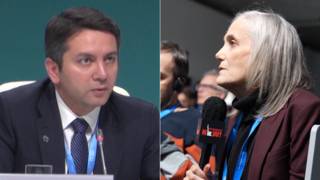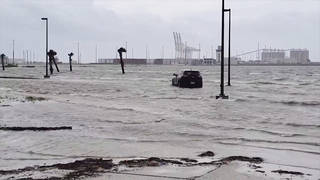
Related
Topics
A year after Hurricane Katrina hit, only about half of New Orleans’ population of 450,000 has returned. Many of those unable to come back are poor and African-American, drastically altering the demographics of a city that used to be two-thirds black. Investigative journalist Greg Palast reports from New Orelans. [includes rush transcript]
Hurricane Katrina flooded 80 percent of New Orleans, destroying the city’s infrastructure and displacing most of its residents. A year later, only about half of New Orleans’ population of 450,000 has returned. Many of those unable to come back are poor and African-American. In the ravaged, mostly black neighborhood of the Lower Ninth Ward–only 1,000 of the 20,000 people who lived there before Katrina have returned. This has drastically altered the demographics of a city that used to be two-thirds black.
Activists and residents have condemned the government’s refusal to re-open the city’s public housing projects and point out that while tourist areas are being developed, affordable housing is not being built. Many are asking, “who is New Orleans being re-built for?”
- Greg Palast, investigative reporter and author of “Armed Madhouse” reports from New Orleans. Produced by Jacquie Soohen of Big Noise Films and Matt Pascarella.
Transcript
AMY GOODMAN: Hurricane Katrina flooded 80% of New Orleans, destroying the city’s infrastructure, displacing most of its residents. A year later, only about half of New Orleans population of 450,000 people has returned. Many of those unable to come back are poor and African American. In the ravaged, mostly Black neighborhood of the Lower Ninth Ward, only 1,000 of the 20,000 people who lived there before Katrina have returned. This has drastically altered the demographics of a city that used to be two-thirds Black. Activists and residents have condemned the government’s refusal to reopen the city’s public housing projects and point out that while tourist areas are being developed, affordable housing is not being built. Many are asking, “Who is New Orleans being rebuilt for?” Here again, investigative reporter Greg Palast, from New Orleans.
GREG PALAST: We drove back to New Orleans to find out what happened to those who tried to return.
What’s wrong, now?
DISPLACED NEW ORLEANS RESIDENT: They just messing all over us?
GREG PALAST: What are they doing?
DISPLACED NEW ORLEANS RESIDENT: Putting you out your own house. Now we ain’t got nowhere to go. You called them back, saying we could come back home. Then when we get there, they got the police coming in there putting us out and others. They’re harassing us. Oh no, this is not right. I’m basically between here and Texas, coming in — you know, coming to see if I could get my house back. And I’m — you know, but I’m in Texas, but I’m coming down here to see about my house. But they say they ain’t letting nobody in and all this. But where we going to go at, though? Where’s we going to go at?
GREG PALAST: What happened?
PATRICIA THOMAS: And then they told us to come back.
GREG PALAST: What happens tonight? Where are you going to go tonight?
DISPLACED NEW ORLEANS RESIDENT: That’s what I want to know, mister. I don’t know where I’m going, me and my kids.
GREG PALAST: Her friend, Patricia Thomas, was also locked out of her home in the Lafitte housing project. The next day, we helped her break into her apartment, barred by metal plates.
PATRICIA THOMAS: This is my porch, right here. I think I might take me a little break and sit on it for a minute. Yeah, this is my porch here.
GREG PALAST: The city has sealed up almost all public housing. But these apartments were never touched by water. It was nearly perfect.
And this, it’s been a year.
PATRICIA THOMAS: It’s been a year, and my house looking good like that.
GREG PALAST: I think you and I together, just the two of us, could put your place back together in a week.
PATRICIA THOMAS: You see?
GREG PALAST: No problem.
PATRICIA THOMAS: No problem at all.
GREG PALAST: But they won’t let her in. And this has nothing to do with Katrina.
PATRICIA THOMAS: Katrina didn’t do this. Man did this. Katrina didn’t come in my house and put these gates up on my windows and things. Katrina didn’t have me walking out here looking for somewhere to stay. Man did this. This was manmade.
GREG PALAST: This is not what we think of as public housing in America. These places are gorgeous, two- and three-story townhouses with iron porticos. Why would the city spend thousands of dollars per unit to armor these places, kick out the tenants? Well, the answer may be over here. This is the downtown business district. We are halfway between there and the tony French Quarter. In other words, this is some very expensive real estate. For years, the city and speculators have been trying to get the tenants out of these apartments. Katrina, the perfect storm, was the perfect excuse. So what kind of New Orleans do they want?
WHITE TOURIST: Would you like a beer?
GREG PALAST: This is the new New Orleans, stripped down, downsized, not too Black, just right for tourists. You could call it Six Flags over Louisiana.
They call this drink a “hurricane.”
But across the Mississippi, far from the Quarter, not everyone is thrilled with this brave new New Orleans of tourists and Mardi Gras.
MALIK RAHIM: It’s two cities. You know? There’s the city for the white and the rich. And there’s another city for the poor and Blacks. You know, the city that’s for the white and rich has recovered. They had a Jazz Fest. They had a Mardi Gras. They’re going to have the Saints playing for those who have recovered. But for those who haven’t recovered, there’s nothing.
GREG PALAST: Malik Rahim is a leader of Common Ground, a grassroots recovery organization. He explains why Patricia and others are locked out of their apartments.
MALIK RAHIM: They didn’t want to open it up. They wanted them closed. They wanted them poor niggers out of there, and they ain’t had no intention to allow it to be reopened to no poor niggers, you know? And that’s just the bottom line.
GREG PALAST: Malik’s group isn’t waiting on George Bush to get around to housing the surviving poor.
MALIK RAHIM: This is a unit we are getting together.
GREG PALAST: Common Ground is completing almost as many homes as the Bush administration, but who’s left? And who will stay?
This is the Lower Ninth Ward, or I should say “was” the Lower Ninth Ward, an African American working class neighborhood. There’s no potable water here. There’s no electricity. There’s no nothing. There’s just no way to return, and a lot of residents feel that’s exactly the plan.
This is Mr. Henry Irving, Sr. He has no neighbors, no water, no electricity, but he is not leaving.
HENRY IRVING, SR.: They want you to leave. That’s what they want us to do. They want us to get discouraged and leave. So why leave? Where I’m going, then? I’m going to go to another community? I put all my life in this community. I’m going to stay here, and if God’s willing, I’m going to be here long enough to see it come back.
GREG PALAST: So can it happen again? Another hurricane? Another flood? Don’t worry, because the government has hired a consulting firm to analyze what went wrong with the response to Katrina. It’s a little firm from Baton Rouge called Innovative Emergency Management.
AMY GOODMAN: Investigative reporter Greg Palast in New Orleans with producer Jacquie Soohen of Big Noise Films.












Media Options